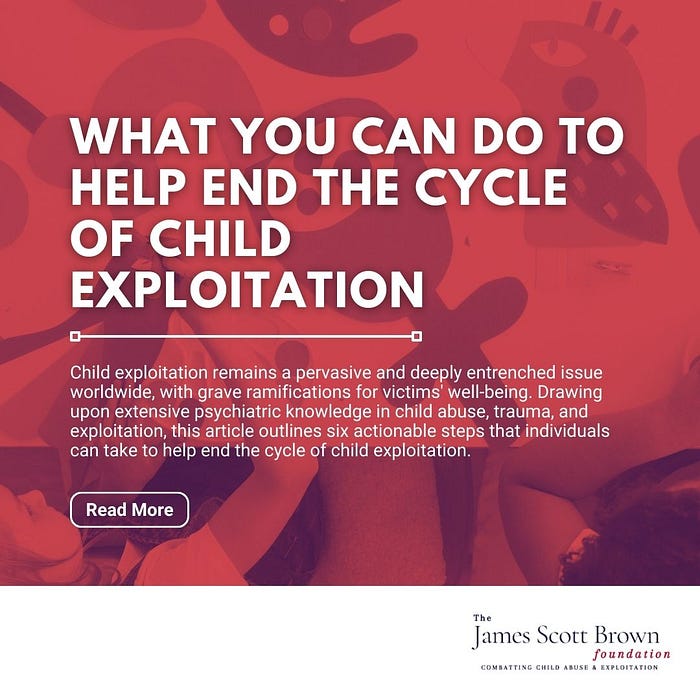What You Can Do to Help End the Cycle of Child Exploitation by James Scott Brown Foundation
by James Scott Brown Foundation

Abstract:
Child exploitation remains a pervasive and deeply entrenched issue worldwide, with grave ramifications for victims’ well-being. Drawing upon extensive psychiatric knowledge in child abuse, trauma, and exploitation, this article outlines six actionable steps that individuals can take to help end the cycle of child exploitation. Through concerted efforts, it is possible to create lasting change and foster a safer environment for vulnerable children.
- Educate Yourself and Others:
Gain a comprehensive understanding of the various forms of child exploitation, including trafficking, forced labor, and online exploitation. Share this knowledge with others in your community to raise awareness and foster a collective commitment to addressing this issue (Laczko & Gozdziak, 2005).
2. Recognize and Report:
Learn to identify the signs of child exploitation and the appropriate reporting mechanisms in your area. Promptly reporting suspected cases can play a critical role in safeguarding children from further harm (Bales & Soodalter, 2009).
3. Support and Collaborate with Local Organizations:
Assist local organizations and NGOs that work to prevent child exploitation and provide support to victims. Volunteering your time, expertise, or resources can significantly enhance their capacity to make a difference (Lemon et al., 2011).
4. Leverage Social Media and Online Platforms:
Utilize social media and other online platforms to raise awareness, share resources, and engage in advocacy efforts. Online activism can contribute to a broader understanding of the issue and galvanize public support for anti-exploitation initiatives (Latonero, 2011).
5. Foster Safe and Inclusive Communities:
Promote a culture of inclusivity and safety within your community, ensuring that children feel empowered to speak up if they have experienced or witnessed exploitation. Encourage open dialogue and provide access to resources and support services (Smallbone et al., 2008).
6. Advocate for Policy Reforms and Improved Services:
Engage in advocacy efforts to advance evidence-based policies and programs addressing child exploitation. By supporting policy reform and the implementation of comprehensive services, individuals can contribute to sustainable change in the fight against child exploitation (Dottridge, 2007).
Conclusion:
Ending the cycle of child exploitation requires the collective efforts of individuals, communities, and organizations. By adopting the strategies outlined above, individuals can make a tangible impact on the lives of children at risk and help create a world free from exploitation.
References:
Bales, K., & Soodalter, R. (2009). The slave next door: Human trafficking and slavery in America today. University of California Press.
Dottridge, M. (2007). Action to prevent child trafficking in South Eastern Europe: A preliminary assessment. UNICEF.
Laczko, F., & Gozdziak, E. (Eds.). (2005). Data and research on human trafficking: A global survey. International Organization for Migration.
Latonero, M. (2011). Human trafficking online: The role of social networking sites and online classifieds. USC Annenberg Center on Communication Leadership & Policy.
Lemon, S. C., Zapka, J., & Clemow, L. (2011). Health behavior change among women with recent familial diagnosis of breast cancer. Preventive Medicine, 53(1–2), 85–91.
Smallbone, S., Marshall, W. L., & Wortley, R. (2008). Preventing child sexual abuse: Evidence, policy, and practice. Willan.
Read more at the James Scott Brown Foundation.
Comments
Post a Comment